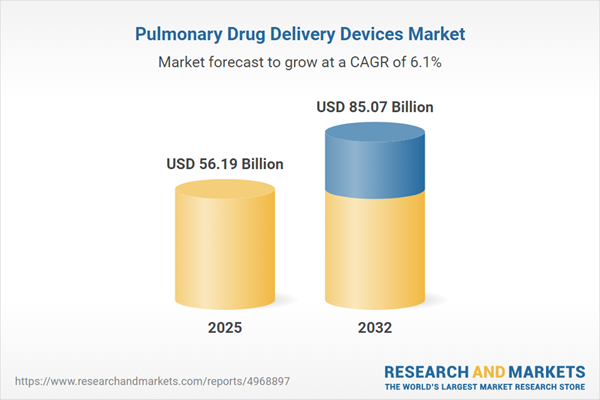Speak directly to the analyst to clarify any post sales queries you may have.
Amid advancing digital transformation and regulatory change, the pulmonary drug delivery devices market offers a prime landscape for senior decision-makers seeking resilient strategies and innovative growth. Addressing shifts in respiratory care, technology, and compliance is critical to sustaining leadership within this evolving sector.
Pulmonary Drug Delivery Devices Market Snapshot
The pulmonary drug delivery devices market continues to expand, underpinned by increasing respiratory disease prevalence and rapid digital health integration. New advancements in device connectivity and design are enhancing clinical workflows and making significant steps forward in care efficiency. Competition in the market remains strong, as major pharmaceutical and device companies prioritize the development of connected technologies to enhance their portfolios. Regulatory evolution and rising sustainability expectations are informing sourcing and manufacturing decisions. Policymakers’ push for environmentally responsible operations, as well as an emphasis on regional production, is placing higher demands on supply chain adaptability and risk management practices in an increasingly complex operating environment.
Scope & Segmentation of the Pulmonary Drug Delivery Devices Market
This comprehensive analysis supplies actionable data and strategic clarity for senior leadership overseeing core segments and emerging opportunities in the pulmonary drug delivery devices market:
- Device Types: Analysis includes dry powder inhalers, metered dose inhalers, nasal sprays, jet nebulizers, mesh nebulizers, ultrasonic nebulizers, and soft mist inhalers, with particular focus on the usability gains and patient adherence improvements brought by digital functionalities.
- Therapy Indications: Evaluates asthma, COPD, allergic rhinitis, bronchiectasis, cystic fibrosis, and pulmonary arterial hypertension, emphasizing evolving trends in patient compliance and clinical management.
- Drug Modalities: Covers the adoption of biologics, monoclonal antibodies, recombinant proteins, combination therapies, advanced vaccine methods, and small molecule drugs, assessing their role in therapeutic innovation and regulatory alignment.
- End Users: Reviews procurement patterns and workflow implications among hospitals, specialty clinics, home healthcare providers, dedicated respiratory care centers, and long-term care facilities, factoring in variations in operational needs.
- Distribution Channels: Details the influence of hospital pharmacies, retail pharmacies, digital health platforms, and e-commerce on market entry prospects and patient engagement strategies.
- Geographic Coverage: Delivers insights into local market drivers, adoption variability, and supply chain challenges across the Americas, Europe, Asia-Pacific, Middle East, and Africa.
- Leading Companies: Examines the strategies of GlaxoSmithKline plc, AstraZeneca plc, Boehringer Ingelheim International GmbH, Teva Pharmaceutical Industries Ltd., Novartis AG, Viatris Inc., Koninklijke Philips N.V., Becton, Dickinson and Company, 3M Company, and AptarGroup, Inc., with attention to how these organizations are shaping the direction and competitiveness of the market.
Pulmonary Drug Delivery Devices: Key Takeaways for Senior Decision-Makers
- Smart inhalers and advanced nebulizers are driving more personalized respiratory care, enabling real-time data collection that supports improved outcomes for patients and streamlined monitoring processes.
- Heightened sustainability mandates prompt organizations to prioritize environmentally responsible materials and evaluate supplier partnerships to better align with future-focused eco-friendly requirements.
- Innovation in biologic and combination therapies encourages the development of targeted, adaptive respiratory treatments, compelling product strategies that closely reflect individual patient needs.
- As digital and e-commerce channels advance, updated engagement and technology investments are necessary to increase patient access and bolster market presence.
- Portable, intuitively designed devices are improving care delivery in home and outpatient settings, widening access to respiratory therapies across diverse user bases.
- Regional distinctions call for tailored approaches, as some areas focus on robust digital integration while others prioritize supply chain integrity and broader accessibility.
Tariff Impact on Global Supply Chains
Recent US tariffs on polymers and pharmaceutical substrates are increasing supply chain expenditures in the pulmonary drug delivery devices market. Manufacturers are responding with more diversified supplier networks, local manufacturing expansion, and focused regional sourcing. These moves are strengthening supply chain resilience, improving logistic operations, and supporting business continuity in the face of evolving regulatory scenarios.
Methodology & Data Sources
This report reflects insights from healthcare executives and clinicians, detailed analyses of scientific publications, patent reviews, regulatory documents, and current digital health trends. The blended methodology ensures data integrity and practical relevance for decision-makers in the pulmonary drug delivery devices sector.
Why This Report Matters
- Enables organizations to prioritize product investments and direct resources for strategic growth within pulmonary drug delivery devices.
- Clarifies the operational impacts of regulatory and digital transformation on risk management and supply chain strategy.
- Empowers leadership to foster continual operational improvement and innovation aligned with patient care and technology trends.
Conclusion
Organizations that adopt targeted market intelligence and proactively adjust strategies to regulatory and technological shifts will secure operational strength and maintain their competitive edge in the pulmonary drug delivery devices market.
Additional Product Information:
- Purchase of this report includes 1 year online access with quarterly updates.
- This report can be updated on request. Please contact our Customer Experience team using the Ask a Question widget on our website.
Table of Contents
3. Executive Summary
4. Market Overview
7. Cumulative Impact of Artificial Intelligence 2025
Companies Mentioned
The companies profiled in this Pulmonary Drug Delivery Devices market report include:- GlaxoSmithKline plc
- AstraZeneca plc
- Boehringer Ingelheim International GmbH
- Teva Pharmaceutical Industries Ltd.
- Novartis AG
- Viatris Inc.
- Koninklijke Philips N.V.
- Becton, Dickinson and Company
- 3M Company
- AptarGroup, Inc.
Table Information
| Report Attribute | Details |
|---|---|
| No. of Pages | 184 |
| Published | October 2025 |
| Forecast Period | 2025 - 2032 |
| Estimated Market Value ( USD | $ 56.19 Billion |
| Forecasted Market Value ( USD | $ 85.07 Billion |
| Compound Annual Growth Rate | 6.0% |
| Regions Covered | Global |
| No. of Companies Mentioned | 11 |









